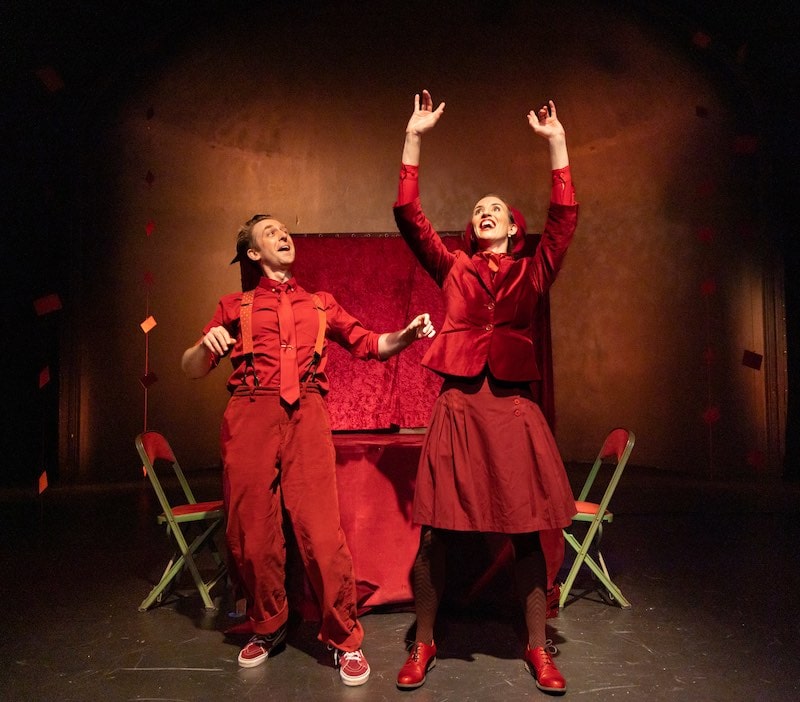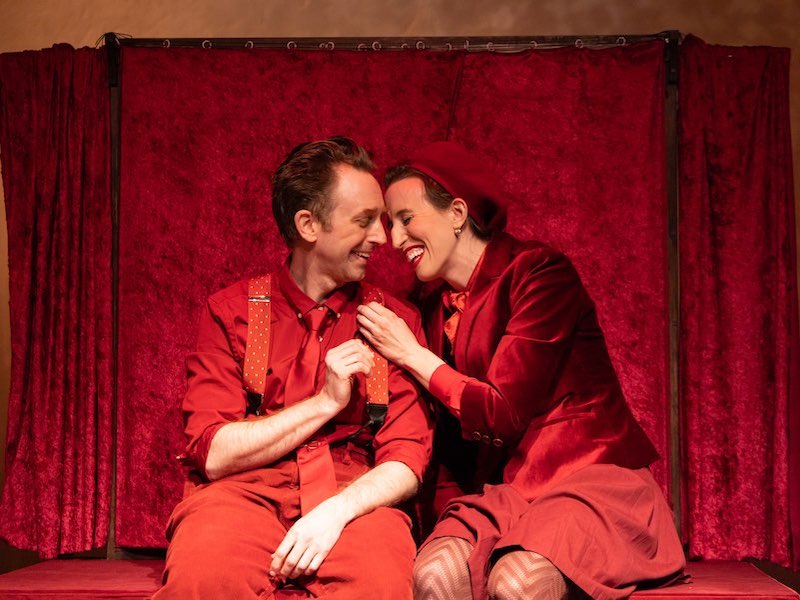Alex Vernon and Sarah Olmsted Thomas, the two remarkable humans of Alex and Olmsted, winners of two Jim Henson Foundation awards for work in puppetry, debut Hubba Hubba, a series of vignettes about romantic love, at Theatre Project in Baltimore through April 2.
The vignettes are quirky, realistic, dreamy, or metaphoric, and you can’t imagine what comes next, from a fantastical character transforming to gain approval to Alex delivering lines so universal many of us have said them, possibly multiple times. They’re also laugh-out-loud funny in about 85% of the show, which makes the poignant 15% even more touching by contrast. After one scene, the audience takes a moment to mourn and forgets to applaud.

Though Alex Vernon and Sarah Olmsted Thomas create the show from top to bottom, they also have an “ask” of the audience. It’s participation, and not merely as applause. In two separate segments, suggestions from the audience are crucial to the progression of the performance.
At street shows or festivals, the audience expects there may be a volunteer going onstage to be an assistant, they may vocalize in a performer-audience call and response, or they may participate in a simultaneous group gesture. This is not that. This is very much not that. In one sequence, Alex and Olmstead attempt to navigate an awkward first-date conversation, taking turns addressing the assembled for help. Alex at one point observes a young adult engaged with a cell phone and says, “Are you on your phone? Are you searching for things for me to talk about?” The youth responds with a topic, which Alex immediately writes into the drama in the time it takes to walk six steps from the edge of the seating back to his spot on the set. In a later portion of the show, an audience member offers an innuendo-laden “matter of the heart,” which Sarah sidesteps, twice, then turns it back on the saucy sir, lobbing him a “grapefruit,” a conversational opening that gives him the opportunity to deliver a punchline, which he does, so it is he who reaps the ensuing laughter.
Impromptu bits are uncommon in proscenium theater, as soliciting audience input is risky. What might they say? Even in daily interactions, most people follow a socially accepted script, in which they respond “You too” to “Have a good day” and “Thanks” to “Nice hat.” Alex and Olmsted invite the audience to say “Donkey Kong,” “Dinosaurs,” and “I miss my grandad,” then incorporate that material in a character- and sequence-appropriate way that often turns out to be hilarious. Being funny from a script is tricky; being funny on the spot is a rare, coveted skill.
Set pieces, designed and built by Alex and Olmsted, consist of a table and a vertical curtain frame, which conceals the performers during some segments and frames them like a television set in others. Nearly everything on the stage is Valentine red; it’s a visual theme. Costuming consists of a “base” outfit for each player, supplemented by accessories or additional pieces to differentiate between characters. These adjustments, combined with differences of posture, position, and movement, create an entire cast of different lovelorn personages, each in some way significant to audience members.
About puppets: you may think you know puppets. I thought I did, then was entranced by a blowing newspaper Alex Vernon created for a Happenstance Theatre show. In Marooned!, a previous Alex and Olmsted production, a power tool created a spinning earth, tiny replicas of onstage characters facilitated a “far away” illusion, and Alex used his own face as a puppet. In Happenstance’s Pocket Moxie, Sarah’s entire body became a marionette, while Alex’s Mentalist character “controlled” her. The puppets of this show are equally surprising (and I’ll save them as a surprise), even when they are only suggested by the performers’ movements.

Something that makes these performers — and their creations — so watchable is their precision. Beyond graceful, lyrical movement, they have split-second timing and responsiveness, as well as a gift for capturing moments of silence. The moment when you’re about to say something then don’t, the moment just after you’ve been interrupted, the moment when you’re thinking about the thing you just said that you wish you hadn’t — and the specific timing of these silences. In Hubba Hubba, such moments are an integrated part of the dialogue, being given as much significance as the dialogue itself. Astounding.
If you’d like to see something sweet, see Hubba Hubba. If you want to look at something technically beautiful, see Hubba Hubba. If you want to enjoy something you’ve never experienced before, see Hubba Hubba. In fact, you can see Hubba Hubba a second time, and still be surprised.
Running Time: Approximately 80 minutes, no intermission.
Hubba Hubba plays through April 2, 2023 (Fridays and Saturdays at 8 PM; Saturdays and Sundays at 3:00 PM), presented by Alex and Olmsted performing at Theatre Project, 45 West Preston Street, Baltimore, Maryland. (Theatre Project doesn’t have its own parking lot. Nearby, there are paid lots and also street parking.) Purchase tickets ($20; Senior/Student/Artist/Military, $15) online or through Theatre Project’s Box Office (410-752-8558).
The program for Hubba Hubba is online here. The show is suitable for all ages.
COVID Safety: All guests must wear masks while inside Theatre Project.
SEE ALSO:
Alex & Olmsted: two people at play with the infinite possibilities of puppets (DCTA Wendy Williams memorial interview by Lisa Traiger, February 15, 2023)
Cybele Pomeroy also reviewed Hubba Hubba for Broadway World.




